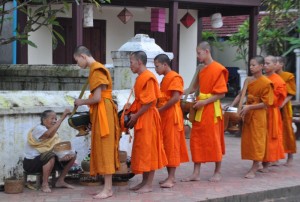 Laos, a land-locked country eclipsed by its neighbours, is often forgotten or seen as a laid-back, under-developed and poor nation. I have been to all the Indochina countries except Laos and am keen to see this lost ancient kingdom. I spent 19 lovely days in northern Laos and visited the Provinces of Luang Nam Tha, Luang Prabang, Xieng Khuang and Vientiane.
Laos, a land-locked country eclipsed by its neighbours, is often forgotten or seen as a laid-back, under-developed and poor nation. I have been to all the Indochina countries except Laos and am keen to see this lost ancient kingdom. I spent 19 lovely days in northern Laos and visited the Provinces of Luang Nam Tha, Luang Prabang, Xieng Khuang and Vientiane.
A landlocked country, Laos shares borders with China, Myanmar, Thailand, Cambodia and Vietnam. The ancient kingdom of The Million Elephants has become the People Democratic Republic of Laos in 1975. It has a population of 6 million and an area of 236,800 square kilometres with a north-south length of 1000km.
Laos, the least populated country in Indochina, has some 50 ethnic groups and some 150 subgroups. The most dominant group is the Lao Loum (Lowland Lao); followed by Lao Thoeng (Upland Lao); tribal Tai and Lao Soung (Highland Lao). A third of the population is living in the main cities with another third along the Mekong River plain.
About 60% of the people are Theravade Buddhists. While the people had contacts with Mahayana Buddhism during 8th – 10th century, Theravade Buddhism was introduced to Luang Prabang in the late 13th and 14th century. Socially, every Lao Buddhist male is expected to become a khuua-baa (monk) for at least a short period in his life.
Mountains and plateaus cover over 70% of the country. Laos can be divided into the mountaineous north and the highest peak, Phu Bia at 2820m is found in the Xieng Khuang Province. The Mekong River dominates the topography and the whole country parallels its course. One can travel by boat from the Thai border at Huay Xai to Luang Prabang and Vientiane. The landscape is spectacular with karst terrain and numerous caves.
For centuries, Laos was a buffer state for centuries and suffered during the Second Indochina War. Being part of the infamous Ho Chi Minh Trail, the Xieng Khuang Province with its world famous Plain of Jars is the most bombed place on earth! There is still an enormous of war debris and unexploded ordnance (UXO) spread across the central and eastern areas of the province. After years of isolation and wars, Laos with its biodiversity and pristine environment, beautiful landscape, impressive architecture, numerous ethnic groups and intact cultures has become a hot destination for globe trotters looking for both culture and nature as well as the young and the restless who flock to Vang Vieng for adventure, tubing, drinking and partying which has become one of the rites of passage of the Indochina backpacking circuit.
4 days in Luang Namtha Province
July 17 (Sunday): Mengla – Botan – Luang Namtha (about 80 km; 3 hrs)
The Chinese government has built a good road from Mengla to the border and has also assisted the Laotian government in building to build the road to Lurang Namtha. The Chinese immigration officials are efficient but I had problems on at the border control at Botan. I have obtained a visa from the Laotian Consulate in Hong Kong but they said I should also have a stamp from the Chinese authority in my passport. I explained that Hong Kong is a Special Administrative Region (SAR) and I have a home visitor card to enter and leave China. Hence the Chinese officers do not stamp on my passport. They looked puzzled and discussed for a long time before allowing stamping on my passport.
I arrived around noon in Luang Namtha, capital of the Luang Namtha Province, which has a population of 45,000 and is synonymous with culture of ethnic tribes, adventure and trekking. I stayed at the Zeula Guesthouse which has been recommended by the French owner of the Mekong Cafe in Jinghong. The town is small and has most of the shops and guesthouses along the 2-km long main street. I explored the town on foot and visited the market where I had my bowl of rice noodles.
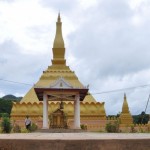 I spent the next two hours walking to a temple on a hillside and then a Black Tai village along the river. Most of the huts are built on a raised platform with a small cooking area outside. Poultry, pigs and cows roam freely in and outside the bamboo fence. The valley has lots of wet rice paddy fields which look fertile and green. I intended to visit the museum but it was already closed.
I spent the next two hours walking to a temple on a hillside and then a Black Tai village along the river. Most of the huts are built on a raised platform with a small cooking area outside. Poultry, pigs and cows roam freely in and outside the bamboo fence. The valley has lots of wet rice paddy fields which look fertile and green. I intended to visit the museum but it was already closed.
I planned to use Luang Namtha as a base. As it is the rainy season, there are not many tourists and there are few group tours. Finally I managed to find a 2-day trekking cum kayaking trip. Price goes down if there are more participants. I was the seventh person to sign up and the cost pp was US$47. I had a nice dinner with half a roast duck and a cold beer in the night market for only 27,000 kips
July 18-19: Luang Namtha – Sin Oudom – Jungle trek – kayaking – Hat Namleng – Luang Namtha (tuk-tuk 68km; jungle trekking 4 hrs; kayaking 20km)
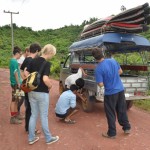 Originally eight persons signed up for this trip. Just before departure, two dropped out. The company asked us to pay on the basis of six persons (around US$50). As some had already paid in full i.e. US$45 on the basis of a group of eight, they refused to pay more. The owner of the company arrived and agreed that we should pay US$45 each. We suggested the company to require a deposit in future to avoid similar problem.
Originally eight persons signed up for this trip. Just before departure, two dropped out. The company asked us to pay on the basis of six persons (around US$50). As some had already paid in full i.e. US$45 on the basis of a group of eight, they refused to pay more. The owner of the company arrived and agreed that we should pay US$45 each. We suggested the company to require a deposit in future to avoid similar problem.
We had a nice group with Nikki from Holland, Inga and Janne from Hamburg, Nick from the UK and Fabien from France and Khong and Khang as our guides. They are all young and energetic. We arrived at a village inhabited by Khmu tribe before 11am. After leaving the bags in a community hut where we would be sleeping that evening, we were taken by a rubber kayak across the Nam Tha River to start our jungle walk. Unfortunately, I fell when I was about to step off from the front of the kayak: the bamboo stick which I tried to grip broke off and the kayak moved. I tried to save my camera by my bag above my head. I failed and water sipped into my Nikon. I was upset as I would not be able to take photos and the camera might have to be written off. I advise Khong and Khang that one of them should be on the river bank and the kayak should stay alongside the river bank to prevent of recurrence of a similar accident.
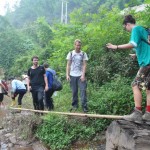 |
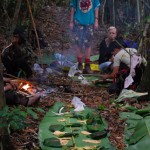 |
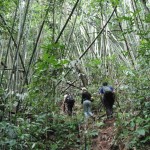 |
This is my first long jungle walk. I discover that I do not enjoy such trekking as the jungle is hot, muddy and humid with lots of mosquitoes and insects. I fell a couple of times and got very muddy. Khong showed us a dozen plants which are edible or can be used as medicine. We had a lovely BBQ lunch with grilled buffalo meat, omelets, sticky rice and salad. Banana leaves are useful: it serves as both a table and a bench for us to sit. Very atmospheric!
The way down was even more slippery. Finally Khang held me my hand to prevent me from falling. We returned to the village before 5pm. I bathed in the river to get rid of the mud. Khong and Khang prepared a delicious dinner with meat and several types of cooked vegetables. They also brought some lao lao (local whisky) which is very strong (about 50 degrees). After dinner, the villagers laid mattresses on the floor of the hut and set up mosquito nets for us. While my young friends had a couple of beers on the balcony, I went to bed and had a wonderful sleep.
I got up early and strolled along the village which has some 20 families with 114 persons. There is a small factory making some kind of oil. But I cannot figure out what the oil is for: I only know it is not a medicine and not for cooking. We had sticky rice and omelets for breakfast and set off in our kayak at 9am. It rained most of the time. The muddy water is warm and the scenery is most beautiful. I enjoy kayaking and feel relaxed watching mountains veiled in mist and clouds. We had a delicious picnic lunch on a small island in the middle of the river. I have never imagined having a warm and well-cooked lunch in the middle of a kayaking trip on the picturesque Nam Tha River.
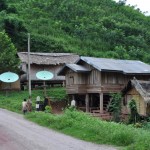 |
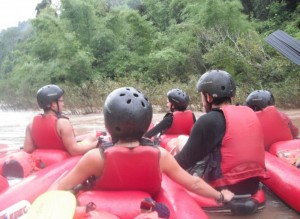 |
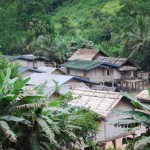 |
July 20: Luang Namtha – Muang Sing – Luang Namtha
I went to Muang Sing by tuk-tuk. The 58-km long journey only takes about an hour on paved road. Muang Sing is close to the Chinese border and there is an obvious Chinese presence of this trading town. On reflection, I could have taken a bus from Mengla, China to Muang Sing, stayed a night before taking a tuk-tuk to Namtha. In any case, I do not find Muang Sing too interesting though the pretty and expansive valley with paddy fields is very picturesque.
5 days in Luang Prabang
July 21: Luang Namtha – Luang Prabang (by bus; about 7 hrs)
Luang Prabang, one of Lao’s two World Heritage Sites, is the country’s foremost tourist showpiece. Encircled by mountains and set 700m above sea level at the confluence of the Nam Khan River and the Mekong River, it became the capital of the first Lao Kingdom Lan Xang Hom Khao (Million Elephants, White Parasol) in 1353 and flourished for the next 200 years. In 1512, King Visoun accepted a celebrated Buddha image – the Pha Bang – as a gift from the Khmer monarchy, the city-state then became known as Luang (Great or Royal) Phabang. In 1545, King Phothisarat moved the capital to Vientiane. When Lan Xang broke up in 1694 following the death of King Suriya Vonga, one of his grandsons set up an independent kingdom in Luang Prabang. When the penultimate Luang Prabang king Sisavang Vong died in 1959, his son Crown Prince Sisavang Vatthana was scheduled to ascend the throne. Following the 1975 revolution, Sisavang Vatthana and his family were exiled and died between 1977 and 1981. Luang Prabang, a religious, cultural, political centre for centuries, is indisputably one of the most beautiful ancient capitals.
I left Luang Namtha on a local bus at 9am. The fare was 90000kips. The scenery is spectacular with soaring mountains, gorges and rivers as well as paddy fields and villages along the route. I fall in love with Luang Prabang once I set my eyes on possibly greenest city in Asia. The Mekong River is fully of activities. Low-rise houses built in traditional or colonial styles are barely visible under the overgrown trees. The town is filled with a religious and spiritual atmosphere with the presence of some 20 wats (temples) and hundreds of monks and novices. I spent five days soaking up the atmosphere and exploring the town.
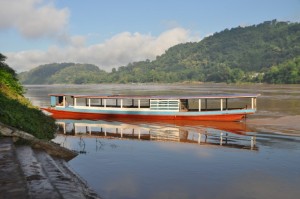 |
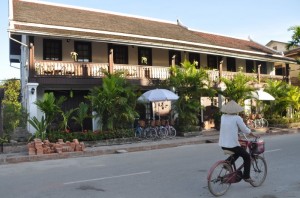 |
July 22: I got up early and had a two-hour walk along the Mekong River. I discovered many side streets at the northern end of the peninsula and spent a long time in Wat Xieng Thong, Luang Prabang’s most magnificent temple. The construction of the sim (ordination hall) was ordered by King Setthathirat in 1560.
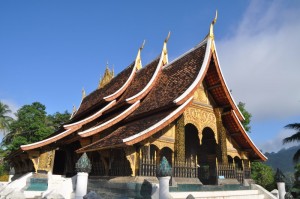 |
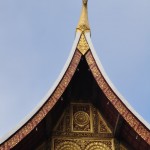 |
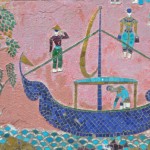 |
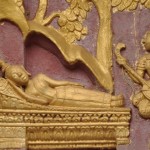 |
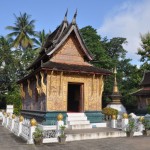 |
I joined a kayaking tour to the Pak Ou caves and met an Italian couple from Milan. The 3-hour kayaking was most enjoyable. The kayak flowed downstream and I had an easy ride. But I prefer kayaking in the Nam Tha River which is narrower with a more intimate atmosphere. The caves with many Buddha statues are famous and used to be patronised by the Royal family. On our way back, we stopped at a whisky village and all of us brought a bottle as souvenir.
After the tour, I spent another hour visiting Wat Wisunarat first built in 1513 and rebuilt in 1896-1898 (the oldest operating temple in Luang Prabang) and Wat Aham (the former residence of the Sangkharat – the Supreme Patriach of Lao Buddhism).
I met up with the Namtha gang and went to the night market for a 10000-kip buffet which is great value for money. I also joined the young people to go to Utopia for a beer before walking back to my guesthouse.
July 23: I spent most of the day wandering around town. I visited many temples along Th Sakkarin and Th Sisavangvong (the main street stretching from the tip of the peninsula to Th Kitasarat) including Wat Khili, Wat si Bun Heuang, Wat Sirimungkhun, Wat Sop, Wat Sensoukarahm, temples on Phu Si (Wat Pha Phutthabaht, Wat Tham Phu Si (Cave Shrine) and That Chomsi) and Wat Mai Suwannaphumaham (which was the residence of the Sangkharat after Wat Aham till that position was moved to Vientiane). My temple tour was interrupted as a result of downpour of rain around 1pm. I took a rest in the guesthouse listening to the rhythm of the rain! Once the rained stopped, I went to see the Royal Palace Museum.
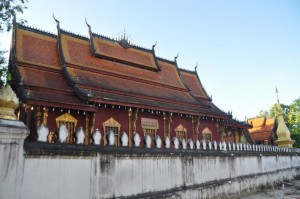 |
I met Sophie and Anna from Holland from the guesthouse. We made a splash and went to Hotel Santi for a sumptuous Royal Luang Prabang dinner with 8 dishes for US$15 per head. The food was delicious and we also had Lao music and dance performance during dinner. On our way to the hotel, we passed by Wat Nong Sikhunmeuang and sat in the sim listening to the soothing chanting of the monks and soaked up the religious and spiritual atmosphere.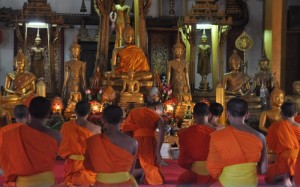
July 24: I had an action-packed day. Waking up at 5am, I went to Th Sakkarin to watch alms giving. In Laos, monks get up at 4am to pray and chant and then go out with their bowl to get food for the day. Buddhists in Laos regard alms giving as their duty and many get up early to cook sticky rice for alms giving. I spent 30000 kips on sticky rice and bananas but the food did not last long. I then stood on the opposite side of the road to watch hundreds of monks in saffron robes in a single file passing by. I am disturbed by the bad behaviours of some tourists who stand so close to the alms -giving person that they almost have the camera in the monk’s face. This is disrespectful.
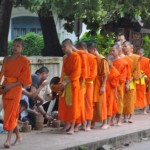 |
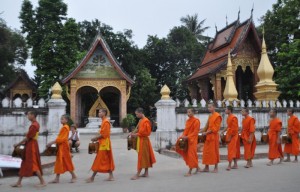 |
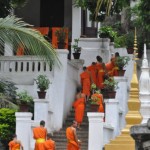 |
There are several cooking schools in Luang Prabang. Food is an important part of culture and I like Lao food which is subtle, simple and delicate, I therefore decided to take my first lesson at the Tum Tum Chen Cooking School. Linda is the chef and we had six students that morning. I had a wonderful morning: I prepared a dish under Linda’s instructions, watched Linda and others preparing sticky rice and seven other dishes. We then sat down to enjoy the food we just prepared including grilled carp and vegetables, fresh spring rolls, beef soup with tamarind, lemongrass chicken, stuffed bamboo sprouts and lemongrass with pork, sweet and sour chicken, ginger fish and sweet sticky rice with fresh fruit. I had the best Lao meal in my life as home-cooking with fresh ingredients is the best and most delicious! My stomach was so full that I skipped dinner.
July 25
: The weather was fine with blue sky and white clouds. As I was tired, I did not get up till 8am. I had a leisure day taking a local ferry (5,000kips only) which dropped me off by a steep flight of steps to Wat Chom Phet at the top of a hill overlooking the Mekong River, the town and the whole area. I sat there for a long time enjoying the undisturbed view and sound of silence. Two children with torches then took me to Wat Tham Xieng Maen (a 100m-deep limestone cave with some Buddha statues) for 10000kips. I followed a well-used and shady path to Wat Long Khun which was where a Luang Prabang king would spend three days in retreat before coronation. Though the wat is not big, it is calm and elegant and features a nicely decorated portico and some fading Jataka murals which I find interesting. They have some similarities with the Japanese wood block painting. I then walked to Ban Xieng Maen (opposite central Luang Prabang) and visited Wat Xieng Maen founded in 1512.
I am fascinated by early explorers’ courage, determination and adventurous spirits. I paid pay homage to Henri Mouhot who discovered Angkor Wat and died in Luang Prabang on November 10, 1861 at the age of 36 (to check)?. I took a tuk-tuk who did not really know the way. We finally managed to arrive at the whitewashed tomb which is by the river. His tomb erected in 1867 was neglected till some foreign aid staff found it in 1949. I gave the driver 100000 kips though we had agreed a price of 50000kips. After all, he spent two hours taking me to the site and other places. The Lao people are nice and honest. I believe in sustainable tourism and we should pay a fair price for good service. I also hope the locals can benefit from tourism like the simple Lao food which I find more subtle and delicate than other Indochina cuisine.
It was a very hot day and I spent the afternoon in the garden to write up my travelogue. Then I took out and checked my camera to see whether it has dried up. To my surprise, the camera works and there is no water mark on the photo. I was thrilled and rushed out with my camera to take photos of the street scenes and temples for three hours. At 8pm, I met my young German friends, Inga and Janne, for a farewell dinner. They are both 19-year-old and will be going to university in September. I invite them to come to HK and stay with me (if I am around).
July 26: Luang Prabang – Phonsavan, Xieng Khuang Province (5 hrs’ driving in minivan)
I got up before 6am and took pictures on alms-giving. I saw Linda, the chef-teacher at Tum Tum Chen Cookery School who gives cooking lessons, sitting on the footpath with lots of sticky rice and food. She gets up everyday around 4am to prepare the rice as she sees it the duty of local people to support the monks. I found the staff of other hotels and many commoners were also giving food to the monks. It is a moving sight.
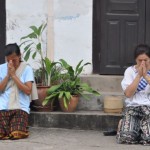 |
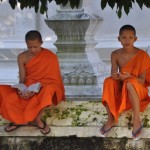 |
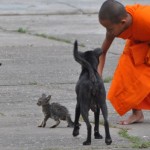 |
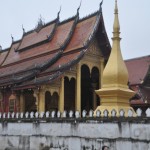 |
I walked towards Mekong and watched the morning mists and the fast flowing river. I took more pictures and then visited the Wat Xieng Thong for the last time before leaving for Phonsavan.
The minivan with 11 passengers set off at 9:30am. We travelled in a mountainous region of Laos and I am fascinated by the landscape and mountain scenery. There are not many people and the land is not under intensive cultivation. Shortly after lunch, we had a flat tyre and the driver took half an hour to fix it. We finally arrived in Phonsavan at 4pm and were met with a heavy downpour of rain. I took a free ride with an agent and looked at two guesthouses. I finally decided to stay at Nice Hotel for 50000kips. The room is decent, simple and clean,For the first time, I had a TV in the room and watched Pheonix TV in Chinese! I had a good sleep as the weather is much cool.
July 27: Visit to the Plain of Jars and Muang Khoun, Xieng Khueng Province
I joined a group tour which covered Site 1 of the Plain of Jars, a Hmong village and Muang Khoun (old Xieng Khuang) which was heavily bombed during the Second Indochina War. I have heard that Site 3 is impressive and asked the driver to take us there as well. He would go if all the nine passengers would give him an extra sum of 20,000kips each. Others agreed and we went straight to Site 3. We had to hike along rice paddy dykes and up a hill. The site is relatively small but atmospheric. The guide explained that the jars were made from a quarry about one kilometre away. But it is not clear how the jars were transported and their usage though a French scholar in 1930s suggested they were used for burial purposes. The jars were thought to be about 2500 years old on the basis of some tools found nearby.
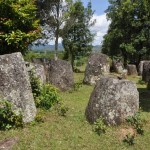 |
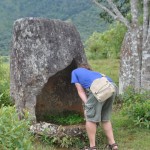 |
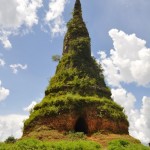 |
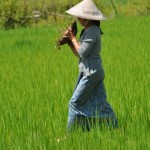 |
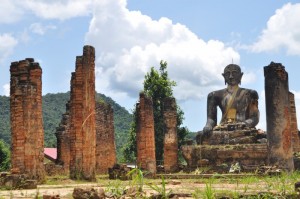 |
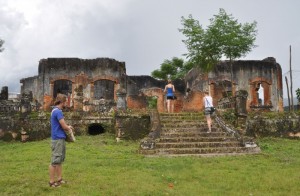 |
We then drove along a well-paved road to Muang Khoun. The town was totally destroyed in 1970s and we first stopped at the ruin Wat Phia Wat which still has a large 600-year old seated Buddha statue. We then went to see a ruin which was once a hospital before going to That Foun, a 30m-high stupa constructed in the Lan Xang/Lanne style at a hill top. We descended to a market and had nice noodle soup before visiting a Hmong village nearby. The village is quite large with over 2000 people. Our final stop was Site 1 of the Plain of Jars. The site is the biggest with over 330 jars including the biggest one with a diameter of 2.5m. There is also a cave nearby and numerous craters created by bombs. It was thundering the whole time but there was no rain.
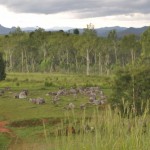 |
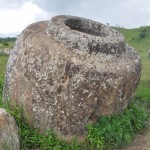 |
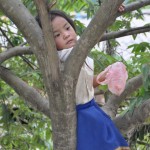 |
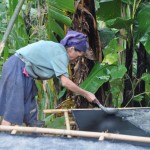 |
8 days in the Vientiane Province (July 28 – August 4)
July 28: I got up early and visited the fresh food market in Phonsavan which starts around 5am. I tried some noodles with fish balls as the lady at the stall looks so elegant and beautiful. The market is large with fresh produces from the countryside. At 8:45am, I departed on a minivan with six passengers and we arrived in Vang Vieng at 2pm. The fare is 110000kips.
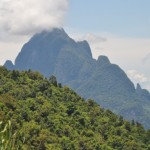 The road is in fairly good condition except for half a dozen potholes. The landscape and scenery is stunning especially from Muang Phu Khoun to Van Vieng with beautiful and huge limestone mountains, paddy fields and patches of green fields for crops high on mountain slopes. It’s photogenic and affords a different view at every turn.
The road is in fairly good condition except for half a dozen potholes. The landscape and scenery is stunning especially from Muang Phu Khoun to Van Vieng with beautiful and huge limestone mountains, paddy fields and patches of green fields for crops high on mountain slopes. It’s photogenic and affords a different view at every turn.
The weather was very hot and I found the heat unbearable. Instead of staying in a backpacker guesthouse, I chose Villa Nam Song on the Nam Song River bank. The villa is right next to the bamboo bridge which appeared in the postcard on Van Vieng. Unfortunately, the bridge has gone but the views from Villa Nam Son on the river and mountains are fantastic. The villa has 16 rooms and I had a room facing the garden. I feel at home and like the place so much that I ended up staying five nights.
The villa is owned by a Frenchmen, Laurent and his Laotian wife, Nindha. They are warm and most welcoming. Nindha’s family comes from Champsak and she lived and studies in Paris when she was young. They live in Thailand and have only returned to Laos ten years ago. They told me a lot about the changes. The country was re-opened in 1990s but few foreigners would come. Their hotel did badly from 2001 to 2005 as it was not safe to travel and several tourists were murdered. The situation has improved since 2004 and the town is getting more and more tourists. Their boutique hotel located far from the town centre is comfortable and tranquil away from the party scene. They will soon be managing another boutique hotel in Luang Prabang with 15 rooms along the Mekong River. I shall return to Luang Prabang one day and hope to stay with them.
I had a most relaxing and enjoyable time in Vang Vieng. Sitting in the verandah cafe, I watched the rain, mountains in the mist and the fast flowing Nam Song while working on my website.
 |
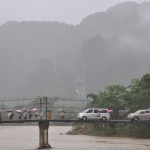 |
I have avoided the town centre which is filled with guesthouses and cheap eateries and packed with young people drinking and partying. But as a ‘professional tourist’, I have also done several ‘must-do’ things.
On July 29, I took a day trip with a German family of three and three travellers from Holland. We went to Ban Tham Sang (a village with picturesque paddy fields) and had tubing in Tham Nam (a water cave) which is most spectacular. The cave is about 500m long and we had headlight on. We also had to crawl on two occasions in order to reach the bigger cave inside. It is pitch dark inside the cave and the water is nice and cool. After lunch, we visited the ‘Elephant Cave’ with a seated Buddha statue and then kayakked for 20kms back to Vang Vieng. We stopped in one of the bars along the river for an hour and a half. I tried the swing and jumped into the water. The most interesting game is to be thrown into the river by sitting at the edge of a huge airbed when another person jumps at the other end. I tried once and did a perfect somersault with applaud from the spectators! I only paid 90000kips and consider it the most value-for-money excursion I have ever taken in my life!
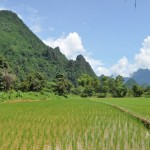 |
I met a nice French couple on the bus to Phonvasan and Vang Vieng. We had a dinner together before they departed for Vientiane. I learnt French while living and working in Brussels in late 1980s. I do not have opportunity to practise after returning to Hong Kong in 1990. I am surprised that I can conduct simple conversations without problem though I have forgotten most of the vocabulary. I like the language and would love to spend a few months in France to learn the language again.
The Koreans were tourists from Vientiane and asked me to them on their tubing trip in the afternoon. We rented a tube for 55000kips each and were taken to the starting point by tuk-tuk. There’s a big party with hundreds of young people singing, dancing and drinking (all free shots!). The Koreans men though no longer young, joined the party while I looked on. I don’t like noise and loud music. It’s getting late and I was relieved when they finally decided to leave.
We set off tubing downstream around 4pm in the rain. The water is warm and fast flowing. The 6-km route can take an hour. About 2kms from Vang Vieng, we stopped for a beer and went to see a cave nearby. For the first time, I saw ‘Opium tea’, ‘Happy Shake’, ‘Mushroom shake’ etc at the bar. I have heard a lot about the availability of ‘mushrooms’ and opium in Vang Vieng from backpackers in Phonsanvan. A backpacker once told me that he spent five days in Vang Vieng partying and drinking from the afternoon to 2 or 3 am. He had tried all sorts of ‘mushrooms’! He said he planned to try opium in Sam Neua before leaving for Vietnam. For a person who does not take drug, I cannot understand their psyche. Drugs bring permanent damage to the brain and health and can destroy one’s life.
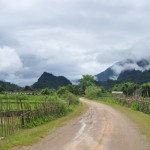 |
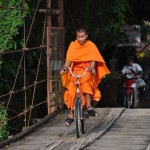 |
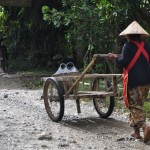 |
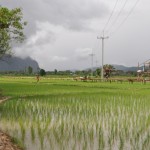 |
It continued to rain in the morning on August 1. Once it stopped around 11:30am, I rented a bicycle at a cost of 15000kips and set off for the Tham Phu Kham (Blue Lagoon) on the other side of Nam Song. The path was so muddy that I got stuck. I had to push my bike on many occasions. I met Janet and Greg from Canada at a store about 3 kilometres from the cave. We took a rest and finally arrived at the cave around 1:30pm. We took some 10 minutes to climb a very steep 200m-high cliff to reach the cave. As we only had a headlight and it’s dark and slippery, we only stayed at the upper chamber at the entrance and looked at the bronze reclining Buddha from a distance. Given my knee problem, I would not have climbed the cliff if I were by myself. My legs were tired as the seat of the bicycle is too low and uncomfortable. Also I had blisters on my right hand. I therefore took a ride in a tuk-tuk chartered by three young British students back and had to pay 35000kips for the 7-km ride.
3 Days in Vientiane
I travelled by minibus to Vientiane in the rain on August 2. The journey takes less than 4 hours and I arrived in my hotel on Th Pangkham close to Nam Phu, before 2pm. Vientiane on the curve of the Mekong River was constructed as the capital by King Setthathirat in the 16th century. The old part of Vientiane along the river is run-down but attractive and atmospheric with colonial as well as traditional houses.
Immediately upon arrival, I made my way to the Mekong River passing by Nam Phu which is surrounded by colonial buildings. Thailand is just on the other side of the river. I passed the Presidential Palace and walked along Th Lang Xang towards Patuxai, reminiscent of the Arc de Triomphe in Paris. By the time I arrived at Talat Sao, Vientiane’s biggest market, torrential rain came down for more than half an hour. I waited in the deserted market till the rain stopped around 6pm. I was hungry and had a quarter of a grilled chicken and a Beerlao by the Mekong River only for 45000kips. The chicken tasted very good: juicy, tender and delicious!
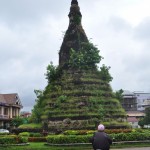 |
I had a full day sight-seeing on foot in Vientiane on August 3. I visited five temples along Th Setthathirat namely Wat Si Saket, Haw Pha Kaeo, Wat Ong Teo Mahawihan, Wat Sok Pa Luang and Wat Inpeng and then the National Museum.
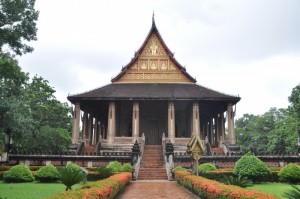 Of these temples, I find the first two more interesting. Wat Si Saket built between 1819 and 1824 by Chao Anou, is Vientiane’s oldest surviving temple which was spared by the Siamese when crashing Chao Anou’s rebellion in 1826. This wat is in an early Bangkok style but surrounded by a thick walled cloister. Over 2000 silver and ceramic buddha images in the small niches of the inner wall of the cloister. In addition, there are over 300 seated and standing Buddha of varying sizes in Lao style resting on the long shelves below the niches. Haw Pha Kaeo wast built on the command of King Setthathirat in 1565 as his personal place of worship and to house the Emerald Buddha. The Siamese stole the Emerald Buddha in 1779 and this wat was razed during the Siamese-Lao war of 1828. It is now a national museum of religious art. I find the exhibits and illustrations in the National Museum appalling.
Of these temples, I find the first two more interesting. Wat Si Saket built between 1819 and 1824 by Chao Anou, is Vientiane’s oldest surviving temple which was spared by the Siamese when crashing Chao Anou’s rebellion in 1826. This wat is in an early Bangkok style but surrounded by a thick walled cloister. Over 2000 silver and ceramic buddha images in the small niches of the inner wall of the cloister. In addition, there are over 300 seated and standing Buddha of varying sizes in Lao style resting on the long shelves below the niches. Haw Pha Kaeo wast built on the command of King Setthathirat in 1565 as his personal place of worship and to house the Emerald Buddha. The Siamese stole the Emerald Buddha in 1779 and this wat was razed during the Siamese-Lao war of 1828. It is now a national museum of religious art. I find the exhibits and illustrations in the National Museum appalling.
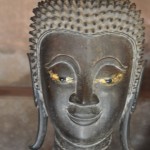 |
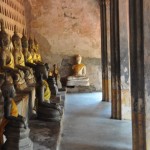 |
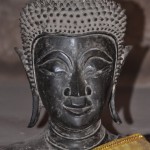 |
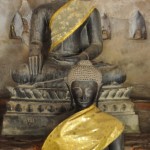 |
It started to rain around 2:30pm. Hence I retired to Vin de France for wine-tasting which only cost US$3 for a nice glass of Shiraz before returning to the hotel for a rest. Rained stopped after 4pm and there were signs for a sunset.
I ventured out and arrived at Patuxai at 5pm. I enjoyed strolling in the tree-lined boulevard and continued to walk to Pha That Luang, which means World-Precious Sacred Stupa, is a symbol of both the Buddhist religion and Lao sovereignty. Pha That Luang was built on the order of King Setthathirat and four wats were also built around the stupa. Wat That Lang Neua to the north remains the residence of the Supreme Patriarch of Lao Buddhism.When I reached Pha That Luang, it was already closed. But I enjoyed looking at the monument at sunset and without tourists. It started to rain again and I took shelter in a nearby temple sitting through the praying and chanting session. A nice Lao lady who was also at the praying session gave me a lift on her motor bike to the parking area. I managed to find a tuk-tuk to the Mekong River. A brilliant sunset suddenly appeared on the Mekong River. I went to the same restaurant for a grilled fish and sticky rice. I was content and returned to my hotel. What a nice day!
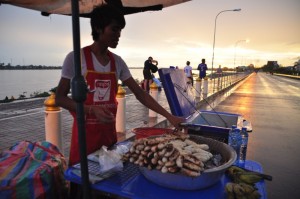 |
I met up with a friend, Mrs Chao and had brunch before leaving for the airport before 12 noon on August 4. She and Dr Chao work for a charity and provide medical services in hospital and in poor areas devoid of such services. My plane scheduled for 2:30pm was delayed. We were taken to a nearby hotel for a rest at 3:30pm and had a sumptuous dinner with 12 dishes at 5:30pm. The plane finally took off around 8pm and I arrived in Kunming at 10pm ending my 19 days’ journey in Laos.
Remarks
Laos has been a buffer state for centuries and is now standing on its own as a sovereign state. It has been the most bombed place on earth and it is still one of the poorest countries in the world. As the places I have visited are on the tourist trail, I have not seen the worst situation. But according to Mrs Chao who has been some very poor areas, there are still many villages in the mountainous region that have no safe drinking water and medical service. Some families are so poor that they do not have a set of clothes for each member. Rich countries and NGOs can play a greater role in lifting the country out of poverty and deal with UXO.
Tourism has indeed been growing fast and steadily for some five years. This industry has become an important source of income. The Chinese government has also announced a plan to build a fast train from Yunnan to Vientiane passing through Luang Prabang and Vang Vieng. Laos is now in a crossroad: I pray the economic development which is essential for bringing its population out of poverty will not corrupt the purity and simplicity of the people. . No doubt, Laos will be changing within a decade. It is therefore critical for the people and the government to retain its unique cultures and the ‘soul’ and ‘spirit’ of this wonderful country.
To my surprise, the Chinese yuan is not yet widely accepted in Laos. Though it is not yet a hard currency, I have the impression that it is widely used in Indochina because of their economic and trade links with China. I was wrong: I tried to exchange yuan at the Laos Development Bank in Muang Sing and BCLC in Vang Vieng and Vientiane without success. I am sure the situation will change in a few years’ time especially on completion of the new railway line to Vientiane.
I love Lao’s magnificent landscape and stunning scenery. The people are unassuming, gentle and soft-spoken. Though they may be poor, they seem to get on with their life. No one has come up to beg me for money as the case in Ethiopia. I have of course been approached on several occasions in Vientiane by the disabled and a few without limbs. The Lao cuisine is simple with subtly and fineness. I enjoy my cooking class and the grilled chicken, duck and fish from the night market or local restaurants. The chili paste goes nicely with the sticky rice. There is so much to offer in Laos and I hope more people will come to discover this lovely country and help the people. As I have only seen northern Laos, I am already planning my next trip to see the south and Luang Prabang again.


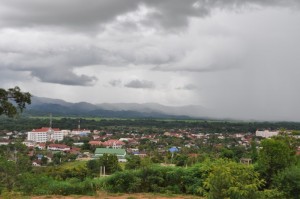
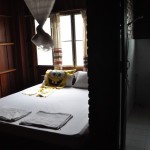
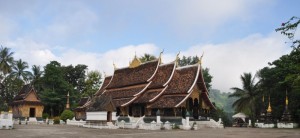
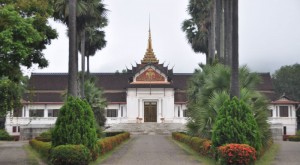
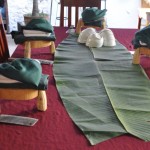
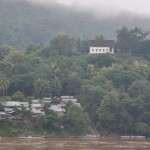
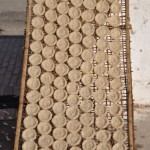
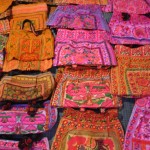
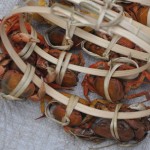
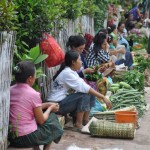
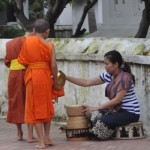
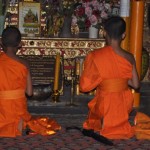
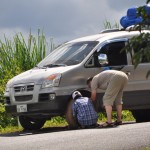
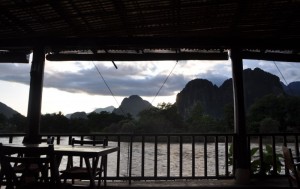
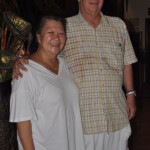
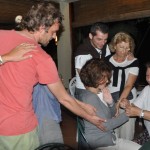
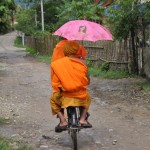
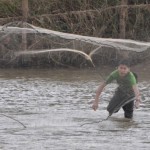
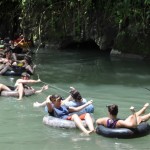
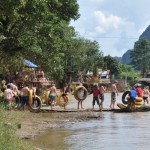
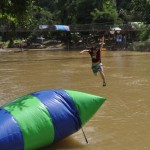
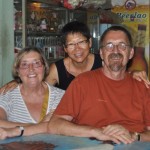
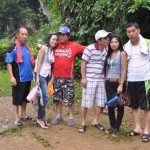
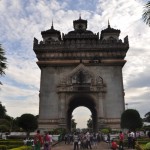
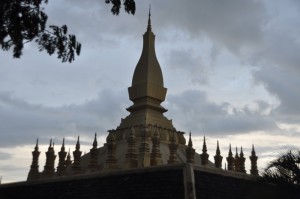
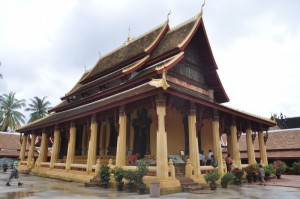
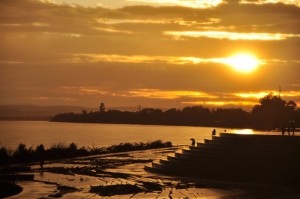
Hi Sarah:
I really enjoy reading this blog on Laos. Laos to me is like Shangrila, a paradise but untouchable. Your travelogs give flesh to that skeleton. I hope your camera is alright and still working. You are brave to do all those adventurous activities, trekking in rain forests, swimming in caves, kayaking in Mekong etc. We have done those at a different era, different age. I am glad you serve as our role model for our golden age. Again, take care!
Paulina
I follow Paulina’s pick this time. Reading through the log, I wanna ask Sarah, ‘Did you do research
before the trip? The information on the country’s history/culture/sites you visited are so impressive. I follow descriptions of your wilderness adventures, tubing sounds exciting …but, somehow in my mind, ‘Jungle and snake go together’..I don’t think I dare to put my feet on it! In particular, I like your remarks and paragraphs on aims-giving, thanks for all the sharing.
Hi Sarah, while reading through your blog, I naturally clicked onto the photos to see a better enlarge view.But several photos do not correspond to the under titles. Also when i click onto one paricular photo, I see another enlarged photo. Strange.
But interesting that you have so much details in the blog especially the historical background and names. I would not have remembered so many. Keep it up !
All the best,
Prudence